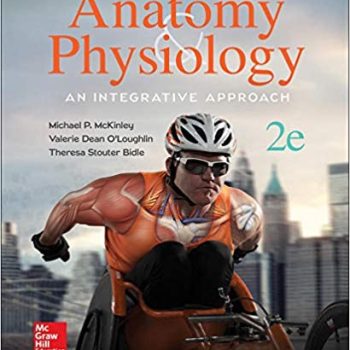Test Bank For Anatomy And Physiology Integrative Approach 2nd Edition by McKinley
Chapter 03 Energy, Chemical Reactions, and Cellular Respiration
True / False Questions
1. Stored energy is described as potential energy.TRUE
Bloom’s Level: 1. RememberLearning Objective: 03.01.01 Describe the two states of energy.Section: 03.01Topic: Cellular respiration
Fill in the Blank Questions
2. The energy of motion is known as _________ energy.kinetic
Bloom’s Level: 1. RememberLearning Objective: 03.01.01 Describe the two states of energy.Section: 03.01Topic: Cellular respiration
Multiple Choice Questions
3.
The sodium level inside and outside of a resting cell is an example of the
A. kinetic energy of sodium rushing out of a cell down its concentration gradient.B. kinetic energy of the large difference in sodium concentration on the inside versus the outside of the cell.C.
potential energy of a concentration gradient, because sodium is more abundant outside the cell.
D.
potential energy of an electron transport chain, because sodium has an extra electron to donate.
E.
conversion of potential energy to kinetic energy, because sodium can never move across the cell membrane and must move across its surface.
Bloom’s Level: 3. ApplyHAPS Objective: C08.01c With respect to the following membrane transport processes – simple diffusion, facilitated diffusion, osmosis, active transport, exocytosis, endocytosis, phagocytosis, pinocytosis, & filtration: Discuss the energy requirements and, if applicable, the sources of energy for each process.HAPS Topic: Module C08 Mechanisms for movement of materials across cell membranes.Learning Objective: 03.01.01 Describe the two states of energy.Section: 03.01Topic: Cellular respiration
True / False Questions
4. The energy stored in a molecule’s chemical bonds is a form of kinetic energy.FALSE
Bloom’s Level: 2. UnderstandLearning Objective: 03.01.02 Describe chemical energy (one form of potential energy) and the various forms of kinetic energy.Section: 03.01Topic: Cellular respiration
Multiple Choice Questions5.
As a runner sprints down a track, her movement is an example of
A. potential energy.B. mechanical energy.C. heat.D. radiant energy.E. chemical energy.
Bloom’s Level: 3. ApplyLearning Objective: 03.01.02 Describe chemical energy (one form of potential energy) and the various forms of kinetic energy.Section: 03.01Topic: Cellular respiration
Fill in the Blank Questions
6. __________ is a monomer that is stored as the polymer glycogen within the liver and muscle.Glucose
Bloom’s Level: 1. RememberHAPS Objective: C04.04a With respect to carbohydrates, proteins, lipids and nucleic acids: Identify the monomers and polymers.HAPS Topic: Module C04 Organic compounds.Learning Objective: 03.01.03 List the three important molecules that function primarily in chemical energySection: 03.01Topic: Cellular respirationEssay Questions
7. Compare and contrast chemical energy and radiant energy. Into which broad category of energy (kinetic or potential) does each fit? What are two examples of each type of energy that relate to human physiology?
Chemical energy is potential energy and radiant energy is kinetic energy. Two examples of chemical energy are triglycerides and complex carbohydrates such as glycogen. Two examples of radiant energy are UV light (a DNA mutagen) and visible light (sensed by the visual system).
Bloom’s Level: 4. AnalyzeLearning Objective: 03.01.02 Describe chemical energy (one form of potential energy) and the various forms of kinetic energy.Section: 03.01Topic: Cellular respirationMultiple Choice Questions
8.
Three molecules that are important energy storage locations in the body are
A. DNA, tRNA, and rRNA.B. glucose, glucagon, and glycogen.C. ATP, glycogen, and triglyceride.D. ADP, DNA, and mRNA.E. glucagon, insulin, and protein.
Bloom’s Level: 1. RememberHAPS Objective: C04.04e With respect to carbohydrates, proteins, lipids and nucleic acids: Discuss physiological and structural roles in the human body.HAPS Topic: Module C04 Organic compounds.Learning Objective: 03.01.03 List the three important molecules that function primarily in chemical energySection: 03.01Topic: Cellular respirationTrue / False Questions
9. The propagation of an impulse along the axon of a neuron is considered electrical energy, a form of kinetic energy.TRUE
Bloom’s Level: 3. ApplyLearning Objective: 03.01.02 Describe chemical energy (one form of potential energy) and the various forms of kinetic energy.Section: 03.01Topic: Cellular respiration
Fill in the Blank Questions
10. The form of kinetic energy that refers to the movement of electromagnetic waves is _________ energy.radiant
Bloom’s Level: 2. UnderstandLearning Objective: 03.01.02 Describe chemical energy (one form of potential energy) and the various forms of kinetic energy.Section: 03.01Topic: Cellular respiration









Reviews
There are no reviews yet.